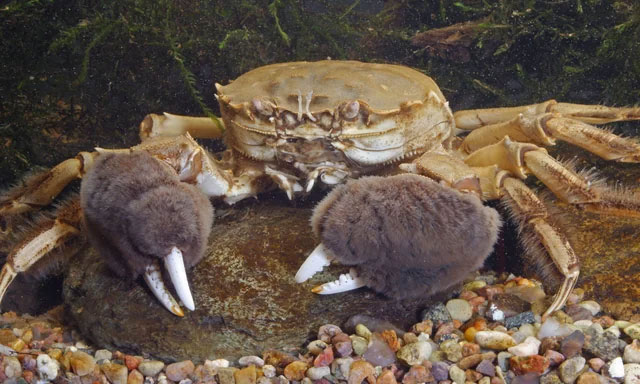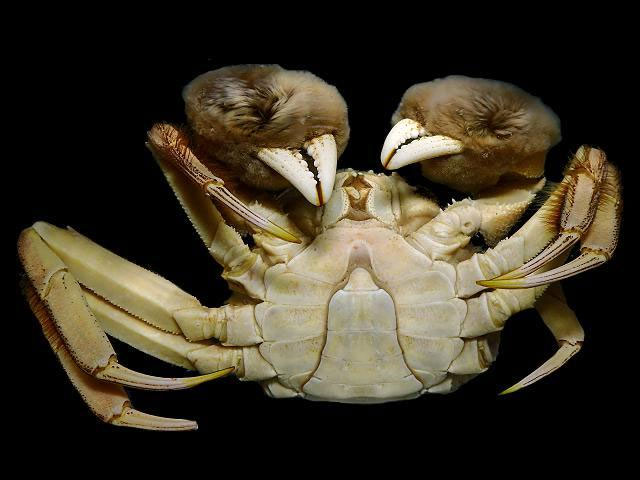Why is the EU spending so much money hunting and destroying millions of Chinese hairy crabs?
Why are EU countries working together to reduce the number of Chinese hairy crabs?
That's because the Chinese hairy crab (scientific name: Eriocheir sinensis) is listed by the International Union for Conservation of Nature (IUCN) as one of the "100 worst invasive alien species in the world."
It is no coincidence that the IUCN classifies the Chinese hairy crab among the world's 100 worst invasive alien species. It can be said that this crab is almost indestructible: It eats almost everything; can live on land as well as in fresh and salt water; especially, it reproduces very quickly and productively, with females laying from 250,000 to 1 million eggs per spawn.
The IUCN further describes: "Eriocheir sinensis is a migratory crab that has invaded Europe and North America from its native range in Asia. During mass migrations, it contributes to temporary local extinctions of native invertebrate species. It alters habitats by causing erosion due to its intensive burrowing activity and costs fisheries and aquaculture hundreds of thousands of US dollars each year through predation and damage to fishing gear."

Close-up of a Chinese hairy crab. (Photo: Aphotomarine).

The underside of a Chinese hairy crab. (Photo: Aphotomarine).
The Chinese hairy crab (also known as the Shanghai hairy crab) is a medium-sized burrowing crab. It gets its name from its hairy claws that resemble furry gloves.
CNN commented , Chinese hairy crabs are a fearsome animal. Their dark brown bodies can grow up to 8cm and when their claws are extended, their entire body can be up to 25cm long.
EU loses tens of billions of euros due to invasive alien species
Hard to believe! But European Union (EU) countries estimate that invasive alien species cause economic damage to member states of up to 12 billion Euros each year.
Invasive alien species (IAS) are animals and plants that have been introduced intentionally or unintentionally into a natural environment where they are not normally found, causing serious negative consequences for their new environment, according to the EU Environment website .
IAS are a major threat to native plant and animal species in Europe and are one of the five main causes of biodiversity loss. They can also have significant negative impacts on the economy (their economic impact in the EU is estimated at around €12 billion per year) as well as on human health, such as causing severe allergies and burns.

Close-up of the "hairy" claw of the Chinese hairy crab. (Photo: Aphotomarine).
That is why the EU has published its Biodiversity Strategy 2030, which commits to managing IAS species and preventing their spread. The Chinese hairy crab is one of them.
The Chinese hairy crab was first discovered in Europe more than a century ago, in a river near Bremen, Germany.
Scientists believe they likely made the journey from their native Asia in the ballast water of ships. Since then, the Chinese hairy crab population across mainland Europe has exploded. The population has grown exponentially, with estimates running into the millions.
Today, 18 of the 27 member states of the European Union report high numbers of the species and have included the Chinese hairy crab on the EU's list of invasive alien species of concern.
EU environmental and biodiversity organizations have repeatedly warned of the negative impacts of the invasive alien species Chinese hairy crab: Disruption of aquatic food chains; transmission of giant freshwater prawn disease; and increased erosion of dykes/banks due to their burrowing for nesting.
Recognizing the economic, human health and biodiversity impacts on the continent, eight scientific organizations from four EU countries (France, Belgium, Germany, Sweden) have collaborated to find a European-level strategy to effectively and permanently reduce this invasive species. In 2023, European scientists agreed on a continental project with the EU not afraid to spend a lot of money called the "Clancy" (full name: European CLANCY project).
Clancy is responding to the massive invasion of the Chinese hairy crab by finding ways to reduce the Chinese hairy crab population, protecting the native ecosystem that is being destroyed by invasive species. to reduce the Chinese hairy crab population.
So far, the most successful strategy is a trap (crab trap) developed by the University of Antwerp and the Flanders Environment Agency in Belgium. Since 2018, Belgium has been piloting this trap, which has caught 3 million Chinese hairy crabs.

Metal traps are installed on the riverbed, where migrating crabs fall into them. Photo: Paul Van Loon/CNN
"Our trap is like a mini metal channel, installed in the river - where the crabs fall into when foraging. Because they cannot swim out like other aquatic species, they are forced to crawl along the pipes leading to cages on both banks. At this point, we will collect and process them" - Jonas Schoelynck, professor of aquatic ecology at the University of Antwerp (Belgium) explained.
Another trap of a similar design, independent of the EU project, is due to be installed in the UK in 2023.
Clancy plans to deploy more traps across Belgium, Germany, France and Sweden in the coming years, then replicate them in other EU countries.
Chinese hairy crabs invade the city
The traps will target areas where large numbers of Chinese hairy crabs migrate . In the fall, adults migrate from freshwater to the sea to spawn, and in the spring, juveniles migrate from the sea up rivers. They are small but can travel incredible distances, up to 10km a day, said Professor Jonas Schoelynck, adding that some have been seen more than 1,000km inland.
During these month-long periods, they are most visible, gathering around sluice gates or moving on land to avoid spillways and other obstacles.
'Sometimes they take the wrong route and end up in the city centre,' said Professor Schoelynck, who recalls hundreds of crabs crawling through the streets of Lier, a small Belgian town at the confluence of two rivers . Here, they can also climb walls and sneak into people's dank bathrooms.
The crabs have thrived in Europe for a number of reasons, European scientists say. Like most invasive species, the Chinese hairy crab has no natural predators, is an opportunistic feeder, and is very resilient. But climate change may also play a role, as warmer waters may make the crabs more comfortable.
There is also strong genetic diversity in the species. Scientists in Europe have reported crabs that are hybrids of Chinese and Japanese mitten crabs . This hybrid crab is better able to survive challenges. This, along with better water quality (in recent decades), and possibly climate change, is contributing to the new crab boom that is being seen across the continent.

Belgium has caught 3 million Chinese hairy crabs from its trapping initiative. (Photo: Heleen Keirsebelik/CNN).
One of the big unanswered questions is what to do with the crabs once they have been collected.
Different countries in the EU have different animal welfare rules, said a scientist at the Alfred Wegener Institute (based in Germany) and involved in the Clancy project. In Germany, scientists are only allowed to kill crabs by boiling or using electric current, while in Belgium they resort to the invasive method of freezing crabs.
While Chinese hairy crabs are a seasonal delicacy in China, Professor Jonas Schoelynck said they have little meat and are therefore not popular on the European market. He added that many of the crabs caught in traps are often juveniles, while those eaten in China are larger adults.
Scientists admit that this is a work in progress, but they hope that a coordinated European effort will help gather knowledge and data about the invasive species and its impacts, helping to shape an international strategy to control populations of the Chinese hairy crab.
- 10 smart spending rules will help you have a relaxed life, always full of money
- Chinese netizens voluntarily eat less invasive crabs to save the US ecosystem
- Spending money has an effect like drugs
- The secret behind the habit of digesting
- 9 rules everyone needs to know about money
- Millions of red crabs migrate to the Gulf of Cuba
- Video: Use millions of dollars in paper money to plant trees
- Amazingly, the crab island spreads all over the city
- Top of unprecedented species of crabs
- The stranded crab dyes red the California coast
- Giant sea crabs with fishermen nets
- How to eat crabs?
 'Fine laughs' - Scary and painful torture in ancient times
'Fine laughs' - Scary and painful torture in ancient times The sequence of numbers 142857 of the Egyptian pyramids is known as the strangest number in the world - Why?
The sequence of numbers 142857 of the Egyptian pyramids is known as the strangest number in the world - Why? History of the iron
History of the iron What is alum?
What is alum?